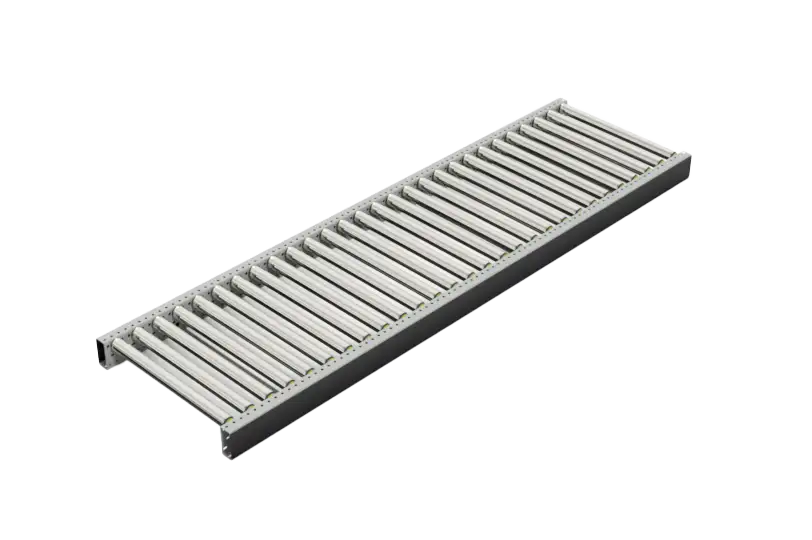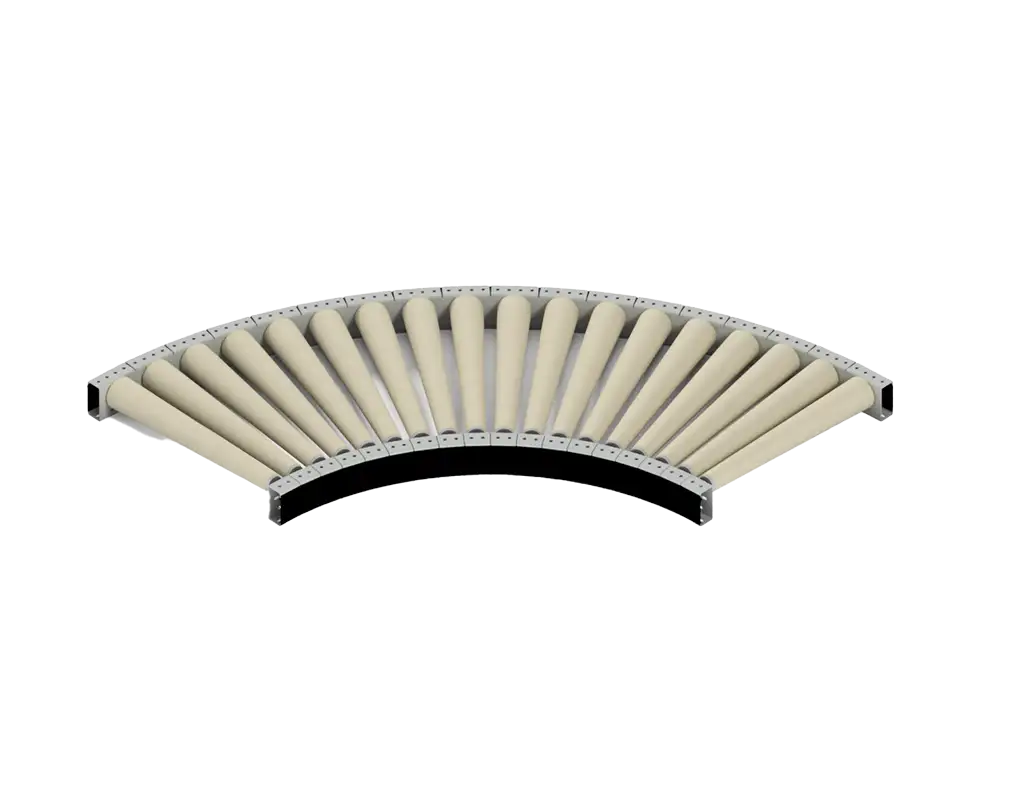Gravity Conveyors
Our range of products
Gravity Conveyors
Gravity Conveyors are a low-maintenance, rugged solution that can improve efficiency and throughput. They come in multiple standard widths and lengths, with 45 and 90-degree curves available.
A gravity conveyor moves the load without utilizing motor power sources, usually down an incline or through a person pushing the load along a flat conveyor. A gravity conveyor can use skate wheels or full rollers.
Gravity Roller Conveyor Straight
Gravity, straight roller conveyor transports material either manually or via gravity down a slope and is used as an assembly and picking line.


Gravity Roller Conveyor Curve
The ball table transports materials with a solid bottom in any horizontal direction using little force. Especially suitable for workstation and inspection areas.
Gravity Conveyor General Specifications
| Lane Width | 400, 500, 600 700, 800, 900, 1000 & 1200 mm (special lane widths on request) |
| Frame | Mild steel ‘C’ section 120mm x 40mm x 2.5mm |
| Module Width | LW + 80 mm |
| Roller Pitch | 60/90/120 & 72 mm for roller curves (other roller pitches on request) |
| Side Guides | 60 – 300 mm high |
| Max Load | 100 kg/per zone |
| Slave Rollers | Mild steel 50mm x 1.5mm dia. BZP tube |
We provide consultation on modular conveyor systems to help you determine the best solution for your needs. Our team has extensive experience in designing, installing, and servicing modular conveyors and can work with you to develop a comprehensive solution. Contact us today to learn more.
See Our Products Range Below
Gravity Conveyors in Modular Conveyor Systems
Introduction
Gravity conveyors are non-powered material handling systems that use the force of gravity to move products, typically on a slight incline or by manual push.
They consist of a series of rollers or wheels mounted in a frame, allowing loads like boxes, cartons, or totes to roll along without a motor. As modular components, gravity conveyor sections can be easily added to or integrated with powered conveyor systems to create a complete workflow, such as gravity spurs or feed lines alongside motorised belts.
Gravity conveyors are a flexible choice when designing conveyor layouts. They enable efficient product flow between different facility areas without additional energy costs.
Types of Gravity Conveyors
Roller Conveyors
Gravity roller conveyors use a series of cylindrical rollers mounted on axles within a frame. Items placed on the rollers can roll along with minimal friction.
Roller conveyors are generally heavier-duty than wheel conveyors. They can handle various loads, including items with irregular or soft bottoms that wouldn’t travel well on wheels (even pallets or drums). They can be installed at a level (for push-assisted movement) or at a decline to let gravity move products.
Join straight sections with curved sections to route items around corners, and use proper roller spacing (often ensuring at least three rollers under each load) to keep items stable during travel.
Skate Wheel Conveyors
Skate wheel conveyors use multiple rows of small wheels (similar to skateboard wheels) mounted on axles. They are very lightweight and suited for medium to lightweight loads with flat, rigid bottom surfaces (such as cartons, trays, or totes). Because each wheel turns independently, these conveyors have low rolling resistance and typically require only a shallow slope to keep products moving.
Lightweight packages move economically on these systems, which work well for loading or unloading, order picking, or assembly areas where items effortlessly glide on the wheel surfaces.
However, skate wheel conveyors are generally not ideal for fragile or irregularly shaped items, and they require enough wheels under an item to support it (a standard guideline is a minimum of ten wheels under a box to prevent sagging).
Flexible Gravity Conveyors
Portable, flexible gravity conveyors bend into various configurations. They typically feature accordion-style frames mounted on casters that expand or contract in length and curve around obstacles as needed.
Available with rollers or skate wheels, these flexible units are ideal for setting up temporary lines for loading or unloading—for example, extending into the back of a truck trailer for loading and then collapsing out of the way when done.
Despite their portability, flexible conveyors are sturdy (often of all-steel construction) and can handle substantial loads. They provide excellent adaptability in modular systems since they can easily be repositioned or reconfigured to match changing workflow needs.
Applications
Warehousing and E-Commerce Fulfilment
Warehouses and distribution centres widely use gravity conveyors for tasks like order picking and carton transport. Workers might pick items into cartons that flow on gravity rollers to consolidation or loading zones in packing and shipping areas. Flexible gravity conveyors are often deployed at loading docks to move packages in and out of trailers quickly.
These uses reduce the manual carrying of goods, speeding up processing and reducing worker fatigue, which is crucial in high-volume retail and e-commerce operations.
Manufacturing and Assembly Lines
In manufacturing plants, gravity conveyors link different workstations or stages of production. They can transport components or assemblies between stations without power, relying on slight inclines or operators to push items along.
Gravity conveyors help move work-in-progress items through assembly lines or between machining and assembly areas. They also serve as accumulation or buffer zones, allowing a line of products to queue up gently between processes.
Packaging and Shipping Operations
Gravity conveyors are standard in packaging lines for transferring boxes and packages between different packaging machines or stations. For example, after cartons are filled and sealed, a gravity roller conveyor might carry them to a labelling station or a palletising area.
Gravity conveyor lanes allow staff to slide cartons from packing tables toward the shipping dock or sorting area in shipping departments, speeding up movement and organising flow.
Order Fulfilment and Retail
Many fulfilment centres and retail distribution facilities rely on gravity conveyors to sort and accumulate orders. For instance, shipping operations might use gravity spiral conveyors or chutes to send cartons from an upper mezzanine down to a shipping area using gravity alone.
Gravity roller sections can serve as overflow or manual package sortation lines in parcel handling.
Benefits of Gravity Conveyors
Cost-Effectiveness
With no motors or complex controls, gravity conveyors are inexpensive to purchase and operate. They require no external power source, eliminating energy costs and reducing upfront investment.
Low Maintenance
Gravity conveyors have few moving parts, making them durable. There are no motors or gearboxes to service, so they require minimal maintenance compared to powered systems.
Ease of Integration
Gravity conveyor modules are easy to integrate into existing layouts or combine with other conveyor types. Their plug-and-play nature makes them flexible when designing or expanding a facility’s conveyor network.
Energy Efficiency
Since they use gravity, these conveyors consume no electricity during operation, making them environmentally friendly and cost-effective.
Safe and Simple Operation
Gravity conveyors are straightforward and generally safe. Workers can interact with them at low risk since there are no powered pinch points or high-speed components.
Design Considerations for Gravity Conveyor Systems
When incorporating gravity conveyors into a modular system, several key design factors should be evaluated:
- Load Capacity and Product Weight: Ensure the conveyor components can handle the weight of the items being transported.
- Incline Angle and Slope: Optimize the decline angle so that products move steadily without stalling or accelerating uncontrollably.
- Product Characteristics: Gravity systems work best with loads that have flat, firm bottom surfaces. Additional considerations like closer roller spacing or guard rails may be necessary for fragile or irregularly shaped items.
- Modularity and Layout Integration: Consider how the conveyor sections will fit within the overall system and whether future expansion will be needed.
By carefully considering these factors, gravity conveyors can be effectively integrated into modular conveyor systems to provide cost-effective, low-maintenance, and energy-efficient material handling solutions.